
Mikoyan-Gurevich MiG-105
Encyclopedia
The Mikoyan-Gurevich MiG-105 was a manned test vehicle to explore low-speed handling and landing.
It was a visible result of a Soviet
project to create an orbital spaceplane
. This was originally conceived in response to the American
X-20 Dyna-Soar
military space project and may have been influenced by contemporary manned lifting body
research being conducted by NASA
's Flight Research Center
in California
. The MiG 105 was nicknamed "Lapot" , or bast shoe
(the word is also used as a slang for "shoe
") for the shape of its nose.
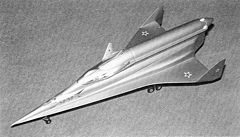 The program was also known as EPOS (Russian acronym for Experimental Passenger Orbital Aircraft). Work on this project finally began in 1965, two years after Dyna-Soar's cancellation. The project was halted in 1969, to be briefly resurrected in 1974 in response to the U.S. Space Shuttle Program
The program was also known as EPOS (Russian acronym for Experimental Passenger Orbital Aircraft). Work on this project finally began in 1965, two years after Dyna-Soar's cancellation. The project was halted in 1969, to be briefly resurrected in 1974 in response to the U.S. Space Shuttle Program
. The test vehicle made its first subsonic free-flight test in 1976, taking off under its own power from an old airstrip near Moscow. It was flown by pilot A. G. Festovets to the Zhukovskii flight test center, a distance of 19 miles. Flight tests, totaling eight in all, continued sporadically until 1978. The actual space plane project was cancelled when the decision was made to instead proceed with the Buran project. The MiG test vehicle itself still exists and is currently on display at the Monino Air Force Museum
in Russia.
Gleb Lozino-Lozinskiy
was the leader of the Spiral development programme.
and was intended to intercept and destroy (if necessary) military space shuttle
missions launched from Vandenberg Air Force Base
.
Its armament purportedly consisted of space-to-space missiles.
It is not known how many times the vehicle flew into space, if any. It is known that two Soviet Air Force
cosmonaut groups, consisting of six in the first group and at least three in the second, were selected and trained to pilot the vehicle. The possibility that the shuttles could now be intercepted and shot down caused quite a stir in the US Department of Defense at the time, which issued several artists' conceptions showing the vehicle on the pad, in space, etc.
After the fatal Space Shuttle Challenger
disaster prompted NASA and the DoD to cancel all planned launches from Vandenberg, it is said that the Soviet Union had no further need for the craft and, in turn, cancelled the Uragan program.
To this day, Russian officials continue to deny that this craft ever existed, leading some to believe that the purported space interceptor was all part of a successful Soviet disinformation
program meant to scare the American military into thinking twice about its plans for the Space Shuttle.
The current whereabouts of any completed Uragan craft or components, if they exist, are unknown.
. Several of these craft have been preserved in aerospace museums around the world.
It was a visible result of a Soviet
Soviet Union
The Soviet Union , officially the Union of Soviet Socialist Republics , was a constitutionally socialist state that existed in Eurasia between 1922 and 1991....
project to create an orbital spaceplane
Spaceplane
A spaceplane is a vehicle that operates as an aircraft in Earth's atmosphere, as well as a spacecraft when it is in space. It combines features of an aircraft and a spacecraft, which can be thought of as an aircraft that can endure and maneuver in the vacuum of space or likewise a spacecraft that...
. This was originally conceived in response to the American
United States
The United States of America is a federal constitutional republic comprising fifty states and a federal district...
X-20 Dyna-Soar
X-20 Dyna-Soar
The X-20 Dyna-Soar was a United States Air Force program to develop a spaceplane that could be used for a variety of military missions, including reconnaissance, bombing, space rescue, satellite maintenance, and sabotage of enemy satellites...
military space project and may have been influenced by contemporary manned lifting body
Lifting body
A lifting body is a fixed-wing aircraft configuration in which the body itself produces lift. In contrast to a flying wing, which is a wing with minimal or no conventional fuselage, a lifting body can be thought of as a fuselage with little or no conventional wing...
research being conducted by NASA
NASA
The National Aeronautics and Space Administration is the agency of the United States government that is responsible for the nation's civilian space program and for aeronautics and aerospace research...
's Flight Research Center
Dryden Flight Research Center
The Dryden Flight Research Center , located inside Edwards Air Force Base, is an aeronautical research center operated by NASA. On March 26, 1976 it was named in honor of the late Hugh L. Dryden, a prominent aeronautical engineer who at the time of his death in 1965 was NASA's deputy administrator...
in California
California
California is a state located on the West Coast of the United States. It is by far the most populous U.S. state, and the third-largest by land area...
. The MiG 105 was nicknamed "Lapot" , or bast shoe
Bast shoe
Bast shoes are shoes made primarily from bast - fiber from the bark of the linden tree or birch tree: they are a kind of basket woven and fitted to the shape of a foot. Bast shoes are an obsolete traditional footwear of forest areas of Northern Europe, formerly worn by poorer members of the Finnic...
(the word is also used as a slang for "shoe
Shoe
A shoe is an item of footwear intended to protect and comfort the human foot while doing various activities. Shoes are also used as an item of decoration. The design of shoes has varied enormously through time and from culture to culture, with appearance originally being tied to function...
") for the shape of its nose.
Development

Space Shuttle
The Space Shuttle was a manned orbital rocket and spacecraft system operated by NASA on 135 missions from 1981 to 2011. The system combined rocket launch, orbital spacecraft, and re-entry spaceplane with modular add-ons...
. The test vehicle made its first subsonic free-flight test in 1976, taking off under its own power from an old airstrip near Moscow. It was flown by pilot A. G. Festovets to the Zhukovskii flight test center, a distance of 19 miles. Flight tests, totaling eight in all, continued sporadically until 1978. The actual space plane project was cancelled when the decision was made to instead proceed with the Buran project. The MiG test vehicle itself still exists and is currently on display at the Monino Air Force Museum
Central Air Force Museum
The Central Air Force Museum in Monino at the site of Monino Airfield 40km east of Moscow, Russia, is one of the world's largest aviation museums, and the largest for Russian aircraft...
in Russia.
Gleb Lozino-Lozinskiy
Gleb Lozino-Lozinskiy
Gleb Evgeniyevich Lozino-Lozinskiy , December 25, 1909 – November 28, 2001) was a Russian and Ukrainian engineer, General Director and General Designer of the JSC NPO Molniya, lead developer of the Russian Spiral and Shuttle Buran programme, Doctor of Science, Hero of Socialist Labour, laureate of...
was the leader of the Spiral development programme.
Differences between Dyna-Soar and Spiral
Although having basically the same mission, Dyna-Soar and Spiral were radically different vehicles. For example:- While the X-20 Dyna-SoarX-20 Dyna-SoarThe X-20 Dyna-Soar was a United States Air Force program to develop a spaceplane that could be used for a variety of military missions, including reconnaissance, bombing, space rescue, satellite maintenance, and sabotage of enemy satellites...
was designed for launch atop a conventional expendable rocket such as the Titan III-CTitan IIIThe Titan IIIC was a space booster used by the United States Air Force. It was launched from Cape Canaveral Air Force Station, FL., and Vandenberg Air Force Base, CA. It was planned to be used as a launch vehicle in the cancelled Dyna-Soar and Manned Orbiting Laboratory programs...
or Saturn I, Soviet engineers opted for a midair launch scheme for Spiral. Known as "50 / 50", the idea was that the spaceplane and a liquid fuel booster stage would be launched at high altitude from the back of a large, airbreathing mothership travelling at hypersonic speeds. The idea was similar to that used by the United States in launching the D-21 Tagboard reconnaissance drone from the back of the A-12 OxcartA-12 OXCARTThe Lockheed A-12 was a reconnaissance aircraft built for the Central Intelligence Agency by Lockheed's famed Skunk Works, based on the designs of Clarence "Kelly" Johnson. The A-12 was produced from 1962 through 1964, and was in operation from 1963 until 1968. The single-seat design, which first...
. The mothership was to have been built by the Tupolev Design BureauTupolevTupolev is a Russian aerospace and defence company, headquartered in Basmanny District, Central Administrative Okrug, Moscow. Known officially as Public Stock Company Tupolev, it is the successor of the Tupolev OKB or Tupolev Design Bureau headed by the Soviet aerospace engineer A.N. Tupolev...
(OKB-156) and utilize many of the same technologies developed for the Tu-144 'Charger'Tupolev Tu-144The Tupolev Tu-144 was a Soviet supersonic transport aircraft and remains one of only two SSTs to enter commercial service, the other being the Concorde...
supersonic transportSupersonic transportA supersonic transport is a civilian supersonic aircraft designed to transport passengers at speeds greater than the speed of sound. The only SSTs to see regular service to date have been Concorde and the Tupolev Tu-144. The last passenger flight of the Tu-144 was in June 1978 with its last ever...
(The Soviet equivalent of the ConcordeConcordeAérospatiale-BAC Concorde was a turbojet-powered supersonic passenger airliner, a supersonic transport . It was a product of an Anglo-French government treaty, combining the manufacturing efforts of Aérospatiale and the British Aircraft Corporation...
) and the Sukhoi T-4Sukhoi T-4-See also:-External links:**...
mach-3 bomber (somewhat similar to the XB-70 ValkyrieXB-70 ValkyrieThe North American Aviation XB-70 Valkyrie was the prototype version of the proposed B-70 nuclear-armed deep-penetration strategic bomber for the United States Air Force's Strategic Air Command...
). It never made it off the drawing boards. The U.S. purportedly flew a similar design in the 1990s under the secret BlackstarBlackstar (spaceplane)Blackstar is the reported codename of a secret United States orbital spaceplane system. The possible existence of the Blackstar program was reported in March 2006 by Aviation Week & Space Technology magazine; the magazine reported that the program had been underway since at least the early 1990s,...
project. - Dyna-Soar was designed with a fixed, delta-wing planform, while Spiral featured an innovative variable-geometry wing. During launch and reentry, these were folded against the sides of the vehicle at a 60-degree angle, acting as vertical stabilizers. After dropping to subsonic speeds post-reentry, the pilot activated a set of electric actuators which lowered the wings into the horizontal position, giving the spaceplane better flight characteristics.
- Spiral was built to allow for a powered landing and go-around maneuver in case of a missed landing approach. An air intake for a single Koliesov turbojet was mounted beneath the central vertical stabilizer. This was protected during launch and reentry by an electric clamshell door, which would open at subsonic speeds. By comparison, Dyna-Soar was designed primarily for a once-off, unpowered deadstick landing, although some documentation claims that its emergency solid-fuel escape rocket (the third stage engine from an LGM-30 MinutemanLGM-30 MinutemanThe LGM-30 Minuteman is a U.S. nuclear missile, a land-based intercontinental ballistic missile . As of 2010, the version LGM-30G Minuteman-III is the only land-based ICBM in service in the United States...
ICBM) could be used for a go-around maneuver if necessary. - Spiral was designed as a lifting body, while Dyna-Soar was designed more like a conventional aircraft.
- High temperature superalloy metals such as niobiumNiobiumNiobium or columbium , is a chemical element with the symbol Nb and atomic number 41. It's a soft, grey, ductile transition metal, which is often found in the pyrochlore mineral, the main commercial source for niobium, and columbite...
, molybdenumMolybdenumMolybdenum , is a Group 6 chemical element with the symbol Mo and atomic number 42. The name is from Neo-Latin Molybdaenum, from Ancient Greek , meaning lead, itself proposed as a loanword from Anatolian Luvian and Lydian languages, since its ores were confused with lead ores...
, tungstenTungstenTungsten , also known as wolfram , is a chemical element with the chemical symbol W and atomic number 74.A hard, rare metal under standard conditions when uncombined, tungsten is found naturally on Earth only in chemical compounds. It was identified as a new element in 1781, and first isolated as...
and rene 41René 41René 41 is a nickel-based high temperature alloy developed by General Electric which retains high strength in the 1200/1800°F temperature range...
were to have been used in the heatshield structure of the X-20. Spiral was to have been protected by what Soviet engineers termed "scale-plate armour": individual steel plates hung from articulated ceramic bearings to allow for thermal expansion during reentry. Several BOR (Russian acronym for Unpiloted Orbital Rocketplane) craft were built and launched to test this concept. - In the event of a booster explosion or in-flight emergency, the insulated crew compartment of Spiral was designed to separate from the rest of the vehicle and parachute to earth like a conventional ballistic capsule; this could occur at any point in the flight. Such an escape crew capsuleEscape crew capsuleAn escape crew capsule allows a pilot to escape from their craft while it is subjected to extreme conditions such as high speed or altitude...
was also considered for Dyna-Soar, but American engineers eventually opted for a solid-fuel escape rocket that would kick the spaceplane away from an exploding booster, saving both pilot and spacecraft. - Much like today's Space Shuttle, Dyna-Soar was designed with a small payload bay behind the pressurized crew module. This could be used for lofting small satellites, carrying surveillance equipment, weapons or even an extra crewmember in a pop-in cockpit. Spiral, on the other hand, appears to have been intended to carry only its pilot. Presumably, this was because the extra space which could have held a payload bay was needed for the Koliesov turbojet and its fuel tanks.
- Both Dyna-Soar and Spiral were designed to land on skids. The landing skids on Dyna-Soar were designed to deploy from insulated doors on the underside of the vehicle, like a conventional aircraft. Soviet engineers, most likely concerned about heatshield integrity, designed the landing skids on Spiral to deploy from a set of doors on the sides of the fuselage just above and ahead of the wings. This unusual arrangement resulted in a hard landing on at least one occasion.
Pilots
A cosmonaut training group for pilots assigned to fly this vehicle was formed in the early 1960s. It went through many changes and was eventually dissolved entirely. Known members included:- Gherman TitovGherman TitovGherman Stepanovich Titov was a Soviet cosmonaut who, on August 6, 1961, became the second human to orbit the Earth aboard Vostok 2, preceded by Yuri Gagarin on Vostok 1...
, the second man to orbit the Earth (see Vostok 2Vostok 2Vostok 2 was a Soviet space mission which carried cosmonaut Gherman Titov into orbit for a full day in order to study the effects of a more prolonged period of weightlessness on the human body...
mission). - A. G. Fastovets, who piloted the vehicle during the majority of its atmospheric tests.
Uragan
Although Spiral itself never made it to the launch pad, it is rumoured that the design was reused and enlarged to build a piloted space interceptor known as "Uragan" (Russian for "Hurricane") in the 1980s. This craft was to have been launched by a Ukrainian-built Zenit expendable boosterZenit rocket
Zenit is a family of space launch vehicles designed by the Yuzhnoye Design Bureau of Ukraine. Zenit was built in the 1980s for two purposes: as a liquid rocket booster for the Energia rocket and, equipped with a second stage, as a stand-alone rocket...
and was intended to intercept and destroy (if necessary) military space shuttle
Military space shuttle
A military space shuttle would be the military equivalent of NASA's space shuttle. Many experts believed that it is extremely unlikely that NASA, the United States Department of Defense or any other Federal agency could keep the existence of such a spacecraft secret, given the official knowledge...
missions launched from Vandenberg Air Force Base
Vandenberg Air Force Base
Vandenberg Air Force Base is a United States Air Force Base, located approximately northwest of Lompoc, California. It is under the jurisdiction of the 30th Space Wing, Air Force Space Command ....
.
Its armament purportedly consisted of space-to-space missiles.
It is not known how many times the vehicle flew into space, if any. It is known that two Soviet Air Force
Soviet Air Force
The Soviet Air Force, officially known in Russian as Военно-воздушные силы or Voenno-Vozdushnye Sily and often abbreviated VVS was the official designation of one of the air forces of the Soviet Union. The other was the Soviet Air Defence Forces...
cosmonaut groups, consisting of six in the first group and at least three in the second, were selected and trained to pilot the vehicle. The possibility that the shuttles could now be intercepted and shot down caused quite a stir in the US Department of Defense at the time, which issued several artists' conceptions showing the vehicle on the pad, in space, etc.
After the fatal Space Shuttle Challenger
Space Shuttle Challenger
Space Shuttle Challenger was NASA's second Space Shuttle orbiter to be put into service, Columbia having been the first. The shuttle was built by Rockwell International's Space Transportation Systems Division in Downey, California...
disaster prompted NASA and the DoD to cancel all planned launches from Vandenberg, it is said that the Soviet Union had no further need for the craft and, in turn, cancelled the Uragan program.
To this day, Russian officials continue to deny that this craft ever existed, leading some to believe that the purported space interceptor was all part of a successful Soviet disinformation
Disinformation
Disinformation is intentionally false or inaccurate information that is spread deliberately. For this reason, it is synonymous with and sometimes called black propaganda. It is an act of deception and false statements to convince someone of untruth...
program meant to scare the American military into thinking twice about its plans for the Space Shuttle.
The current whereabouts of any completed Uragan craft or components, if they exist, are unknown.
BOR
The БОР . Another spacecraft to use the Spiral design was the BOR series, unmanned subscale reentry test vehicles. American analogs X-23 PRIME and ASSETASSET (spaceplane)
-Winged Gemini:In the mid-1960s, McDonnell proposed a variant of the Gemini capsule which retained the original spacecraft's internal subsystems and crew compartment, but dispensed with the tail-first ballistic reentry, parachute recovery and water landing....
. Several of these craft have been preserved in aerospace museums around the world.
| Image | Type | Launch date | Usage | Current status |
|---|---|---|---|---|
| BOR-1 | 15.07.1969 | Flight test, the experimental 1:3 scale model. Burned in the atmosphere at a height of about 60-70 km with the speed 8 000 mph (13 000 km/h). Was deployed at an altitude 328,083 ft (100 km) by 11K65 |
Burned(planned). | |
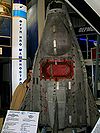 |
BOR-2 | 1969 - 1972 | Sub-scale model of the Spiral space plane. 4 launches. | NPO Molniya NPO Molniya NPO Molniya is a Russian scientific and production enterprise, founded on February 26, 1976 prior to and for the creation of Shuttle Buran. At present, NPO Molniya carrying works on the reusable launch systems.- External links :*... , Moscow |
| BOR-3 | 1973 - 1974 | Sub-scale model of the Spiral space plane. 2 launches. 1. Destruction of the nose fairings after launch at a height of about 5 km (speed 0.94 Mach). 2. Flight program is fully implemented. Crashed on landing (Parachute failure) |
Crushed. | |
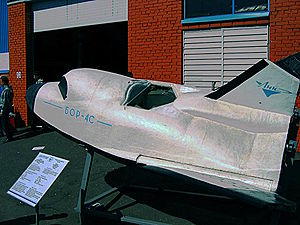 |
BOR-4 BOR-4 The BOR-4 flight vehicle is a scaled prototype of the Soviet Spiral VTHL spaceplane. An unmanned, subscale craft, its purpose was to test the heatshield tiles and reinforced carbon-carbon for the Buran space shuttle, then under development... |
1980 - 1984 | Sub-scale model of the Spiral space plane. 4 launches and 2 unconfirmed | NPO Molniya NPO Molniya NPO Molniya is a Russian scientific and production enterprise, founded on February 26, 1976 prior to and for the creation of Shuttle Buran. At present, NPO Molniya carrying works on the reusable launch systems.- External links :*... , Moscow |
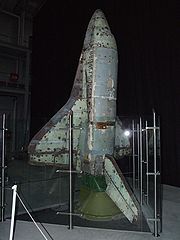 |
BOR-5 BOR-5 The BOR-5 flight vehicle was used to test the main aerodynamic characteristics, thermal and acoustic loads and stability for the Shuttle Buran program... |
1984 - 1988 | Flight tests, the experimental sub-scale base model. 5 launches. Data was also used in the Buran project. | Technik Museum Speyer Technik Museum Speyer The Technik Museum Speyer is a technology museum in Speyer , Germany.- History :The museum was opened in 1991 as a daughter of the Sinsheim Auto & Technik Museum and is run by a registered alliance called "Auto & Technik Museum Sinsheim e.V.". , it has more than 2,000 exhibits and an exhibition... , Germany Museum in Monino Central Air Force Museum The Central Air Force Museum in Monino at the site of Monino Airfield 40km east of Moscow, Russia, is one of the world's largest aviation museums, and the largest for Russian aircraft... , Russia |
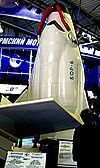 |
BOR-6 | Sub-scale model of the Spiral space plane | NPO Molniya NPO Molniya NPO Molniya is a Russian scientific and production enterprise, founded on February 26, 1976 prior to and for the creation of Shuttle Buran. At present, NPO Molniya carrying works on the reusable launch systems.- External links :*... , Moscow |

